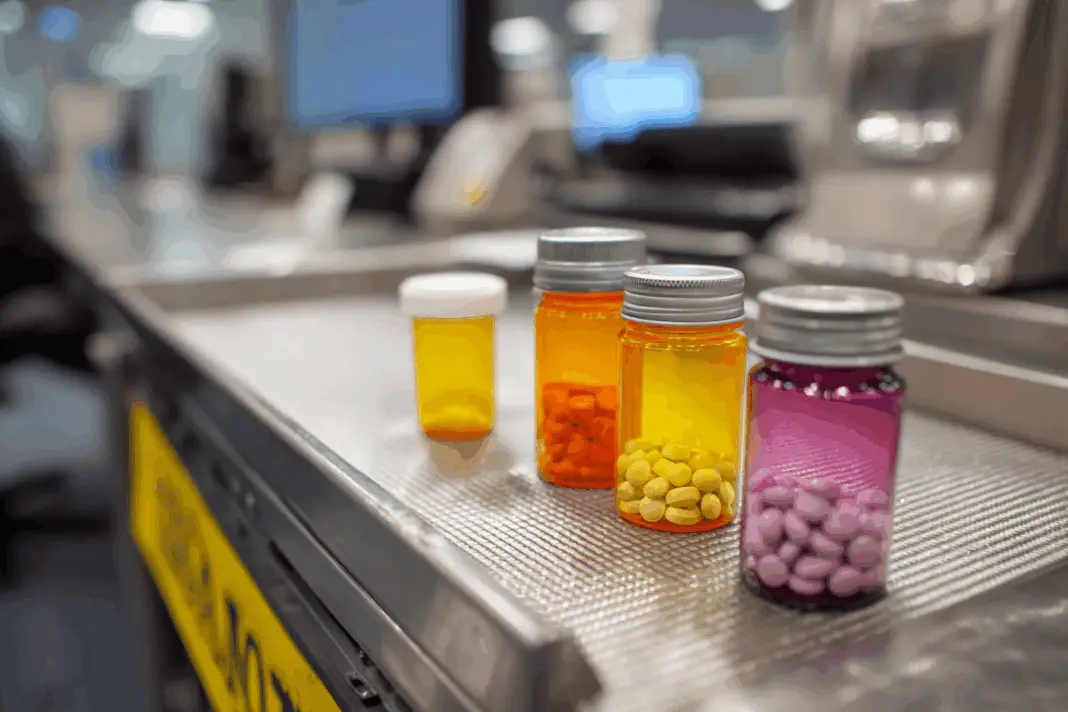Getting through airport security with medications should be simple, but thousands of travelers find their pills, inhalers, and even life-saving prescriptions confiscated every year. The problem isn’t that TSA agents are being difficult – it’s that most people don’t realize they’re making critical mistakes that immediately flag their medications as suspicious. These aren’t obscure rules hidden in fine print, but basic requirements that can turn a smooth trip into a medical emergency if your essential medications get taken away.
Forgetting to declare liquid medications over 3.4 ounces
Most travelers know about the 3-1-1 rule for liquids, but many don’t realize this applies to liquid medications too. Prescription cough syrup, liquid antibiotics, insulin, and eye drops all count as liquids. If any single medication container holds more than 3.4 ounces, it needs special handling. The biggest mistake people make is tossing these medications in their carry-on bag and sending it through the scanner without saying anything to TSA agents first.
The correct procedure requires declaring these medications before your bag goes through the X-ray machine. TSA agents need to separately screen larger liquid medications, which takes extra time but keeps your medicine with you. Failing to identify oversized liquid medications upfront creates confusion and delays. Some travelers have watched their expensive prescription medications get thrown away because they didn’t speak up at the right moment.
Packing pills in unmarked containers or pill organizers
Weekly pill organizers seem like a smart way to travel light, but they create major problems at security checkpoints. TSA agents can’t verify what medications you’re carrying when pills are mixed together in unmarked compartments. This is especially problematic for controlled substances like pain medications, anxiety pills, or ADHD medications. Even common prescription drugs become suspicious when they’re not in their original pharmacy bottles with proper labels.
The safest approach is keeping all medications in their original pharmacy containers, even if it means carrying multiple bottles. If space is tight, ask your pharmacist for smaller travel-sized bottles with proper labels. This mistake gets people stopped more often than liquid violations because TSA agents have no way to verify legitimate prescriptions. Some travelers have faced questioning, missed flights, or had medications confiscated because they couldn’t prove their pills were legally prescribed.
Not carrying prescription documentation for controlled substances
Controlled substances like opioid pain relievers, benzodiazepines, and stimulants require extra documentation beyond the pharmacy label. Many travelers assume the prescription bottle is enough, but TSA and customs agents sometimes need additional proof that you’re legally prescribed these medications. This becomes critical if you’re carrying large quantities or traveling internationally where drug laws are stricter than in the United States.
Smart travelers carry a letter from their doctor explaining their medical condition and prescribed medications. This letter should include your name, the doctor’s contact information, generic and brand names of medications, and dosages. Keep copies of recent prescriptions and pharmacy receipts as backup documentation. Some people have faced serious legal issues when foreign customs officials questioned their controlled substances without proper documentation to prove legitimate medical use.
Carrying someone else’s prescription medications
Parents often carry medications for their children, and adult children sometimes help elderly parents manage prescriptions during travel. However, carrying prescription medications that aren’t prescribed to you is technically illegal, even with good intentions. This includes carrying your spouse’s heart medication “just in case” or bringing extra insulin for a diabetic family member. TSA agents and law enforcement take prescription drug laws seriously, regardless of family relationships.
Each person should carry their own medications whenever possible. For children or dependents who can’t manage their own medications, parents or caregivers should carry documentation proving their relationship and authority to possess these prescriptions. TSA can confiscate medications even when they’re life-saving prescriptions if you can’t prove you’re legally authorized to carry them. Some families have faced serious delays when well-meaning relatives got caught carrying medications prescribed to other family members.
Mixing prescription and over-the-counter medications together
Combining prescription medications with over-the-counter pills in the same container creates identification problems for TSA agents. Even something as simple as adding Tylenol to a prescription bottle makes it impossible to verify what medications you’re actually carrying. This mixing becomes especially problematic when prescription bottles contain pills that look different from what the label describes, raising red flags about potential drug trafficking or illegal substances.
Keep all medications separate in their original packaging to avoid confusion. Over-the-counter medications should stay in their store packaging or clearly labeled bottles. Prescription medications must remain in pharmacy containers with original labels intact. This separation helps TSA agents quickly verify your medications are legitimate and reduces the chance of additional screening or questioning. Some travelers have experienced long delays while agents tried to identify mixed medications that couldn’t be properly verified.
Failing to research medication laws for international destinations
Medications that are perfectly legal in the United States can be completely banned in other countries. Common examples include certain pain medications, ADHD stimulants, and anxiety medications that are controlled or prohibited in countries like Japan, Singapore, and the United Arab Emirates. Some travelers have been arrested and imprisoned for carrying medications that they legally use in America but are considered illegal drugs in their destination country.
Research medication laws for every country you’ll visit, including layover destinations where you might clear customs. Contact embassies or consulates for official guidance on bringing specific medications into their country. One mistake could mean confiscation at customs or serious legal consequences. Some countries require special permits or import licenses for certain medications, even when you have valid American prescriptions. Planning ahead prevents vacation-ruining surprises at international borders.
Packing all medications in checked luggage instead of carry-on
Checked luggage gets lost, delayed, or sent to wrong destinations more often than most people realize. When essential medications are packed in checked bags, travelers can face serious health risks if their luggage doesn’t arrive on time. This is especially dangerous for people with diabetes, heart conditions, or other medical issues requiring daily medication. Even a one-day delay in accessing critical medications can create medical emergencies.
Always pack essential medications in carry-on luggage where you can access them throughout your trip. Bring extra supplies in case of travel delays or extended stays. Consider packing a few days’ worth of backup medications in checked luggage, but never rely on checked bags for your primary medication supply. TSA rules specifically allow necessary medications in carry-on bags because they understand the health risks of separating travelers from essential prescriptions.
Not understanding insulin and medical device regulations
Diabetic travelers face unique challenges with insulin, glucose monitors, and medical devices that many people don’t understand. Insulin doesn’t need to be refrigerated during short trips, but it must be properly labeled and declared at security checkpoints. Continuous glucose monitors and insulin pumps can interfere with X-ray machines and metal detectors, requiring alternative screening procedures that take extra time.
Diabetic supplies like test strips, lancets, and glucose tablets are allowed in carry-on bags but should be clearly labeled and easily accessible for inspection. Medical devices may require special handling or manual pat-downs instead of going through standard screening equipment. Inform TSA agents about medical devices before screening begins to avoid damage or delays. Some diabetic travelers carry letters from their doctors explaining their medical equipment and supplies to speed up the security process.
Assuming all inhalers and emergency medications are automatically allowed
Rescue inhalers, EpiPens, and emergency medications are generally allowed through security, but they still need proper labeling and sometimes additional screening. Prescription inhalers should have pharmacy labels or prescription information to verify they’re legitimately prescribed medical devices. Generic or unlabeled inhalers can be confiscated if TSA agents can’t verify they’re real medical devices rather than prohibited substances.
EpiPens and other auto-injectors need to be easily identifiable and properly labeled with prescription information. Some emergency medications require temperature control or special storage that affects how they can be packed and transported. TSA rules around emergency medications can be confusing because they balance medical necessity with security requirements. Keep these devices easily accessible in your carry-on bag and be prepared to explain their medical purpose if questioned by security agents.
Traveling with medications doesn’t have to be stressful when you understand TSA requirements and plan accordingly. Keep prescriptions in original containers, declare liquid medications over 3.4 ounces, and research international medication laws before you travel. A little preparation prevents major problems that could leave you without essential medications far from home.

